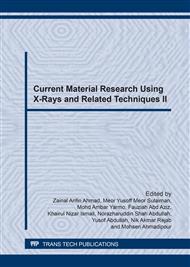[1]
J. M. Benito, X. Turrillas, G. J. Cuello, A. H. De Aza, S. De Aza, M. a. Rodríguez, Effect of melting temperatures on the crystallization and densification of 2. 8MgO·1. 5Al2O3·5SiO2 glass–ceramic synthesized from mainly talc and kaolin. J. Eur. Ceram. Soc., 32(2)(2013).
DOI: 10.1016/j.jallcom.2010.10.077
Google Scholar
[2]
R. Bejjaoui, A. Benhammou, L. Nibou, B. Tanouti, J. P. Bonnet, A. Yaacoubi, A. Ammar, Synthesis and characterization of cordierite ceramic from Moroccan stevensite and andalusite, Appl. Clay Sci. 49(3)(2010) 336–340.
DOI: 10.1016/j.clay.2010.06.004
Google Scholar
[3]
G. Parcianello, E. Bernardo, P. Colombo, Cordierite ceramics from silicone resins containing nano-sized oxide particle fillers. Ceram. Int. 39(8)(2013) 8893–8899.
DOI: 10.1016/j.ceramint.2013.04.083
Google Scholar
[4]
M.M.S. Sanad, M.M. Rashad, E.S.A. Abdel-Aal, M.F. El-Shahat, K.W. Powers, Extending and Enhancing the Properties of Porous Cordierite Ceramics by Mo 6+ ion Incorporation via Facile Combined Synthesis Technique, Int. J. Appl. Ceram. Technol. 11(5)(2014).
DOI: 10.1111/ijac.12237
Google Scholar
[5]
E.M.M. Ewais, Y.M.Z. Ahmed, A.M.M. Ameen, Preparation of porous cordierite ceramic using a silica secondary resource ( silica fumes ) for dust filtration purposes, Journal of Ceramic, 10(6)(2009) 721–728.
Google Scholar
[6]
X. Guo, K. Nakanishi, K. Kanamori, Y. Zhu, H. Yang, Preparation of macroporous cordierite monoliths via the sol–gel process accompanied by phase separation, J. Eur. Ceram. Soc. 34(3)(2014) 817–823.
DOI: 10.1016/j.jeurceramsoc.2013.08.016
Google Scholar
[7]
H. Bartar Esfahani, B. Eftekhari Yekta, V.K. Marghussian, Sintering, crystallization and mechanical properties of a gel-cast cordierite glass–ceramic body, Ceram. Int. 38(2)(2012) 1523–1527.
DOI: 10.1016/j.ceramint.2011.09.036
Google Scholar
[8]
X. Deng, J. Wang, J. Liu, H. Zhang, F. Li, H. Duan, L. Lu, Z. Huang, W. Zhao, S. Zhang, Preparation and characterization of porous mullite ceramics via foam-gelcasting, Ceram. Int. 41(7)(2015) 9009–9017.
DOI: 10.1016/j.ceramint.2015.03.237
Google Scholar
[9]
J. Banjuraizah, H. Mohamad, Z.A. Ahmad, Effect of melting temperatures on the crystallization and densification of 2. 8MgO·1. 5Al2O3·5SiO2 glass–ceramic synthesized from mainly talc and kaolin, J. Alloys Compd. 509(5)(2011) 1874–1879.
DOI: 10.1016/j.jallcom.2010.10.077
Google Scholar
[10]
M. Fuji, T. Kato, F.Z. Zhang, and M. Takahashi, Effects of surfactants on the microstructure and some intrinsic properties of porous building ceramics fabricated by gelcasting, Ceram. Int. 32(7)(2006) 797–802.
DOI: 10.1016/j.ceramint.2005.06.003
Google Scholar
[11]
K. Prabhakaran, C. Pavithran, Gelcasting of alumina from acidic aqueous medium using acrylic acid, J. Eur. Ceram. Soc. 20(8)(2000) 1115–1119.
DOI: 10.1016/s0955-2219(99)00244-7
Google Scholar
[12]
J. Yang, T. Ohji, S. Kanzaki, Microstructure and mechanical properties of silicon nitride ceramics with controlled porosity, J. Am. Ceram. Soc. 16(6)(2002) 1512–1516.
DOI: 10.1111/j.1151-2916.2002.tb00305.x
Google Scholar
[13]
J. C. Le Huec, T. Schaeverbeke, D. Clement, J. Faber, A. Le Rebeller, Influence of porosity on the mechanical resistance of hydroxyapatite ceramics under compressive stress, Biomaterials, 16(2)(1995) 113–118.
DOI: 10.1016/0142-9612(95)98272-g
Google Scholar


